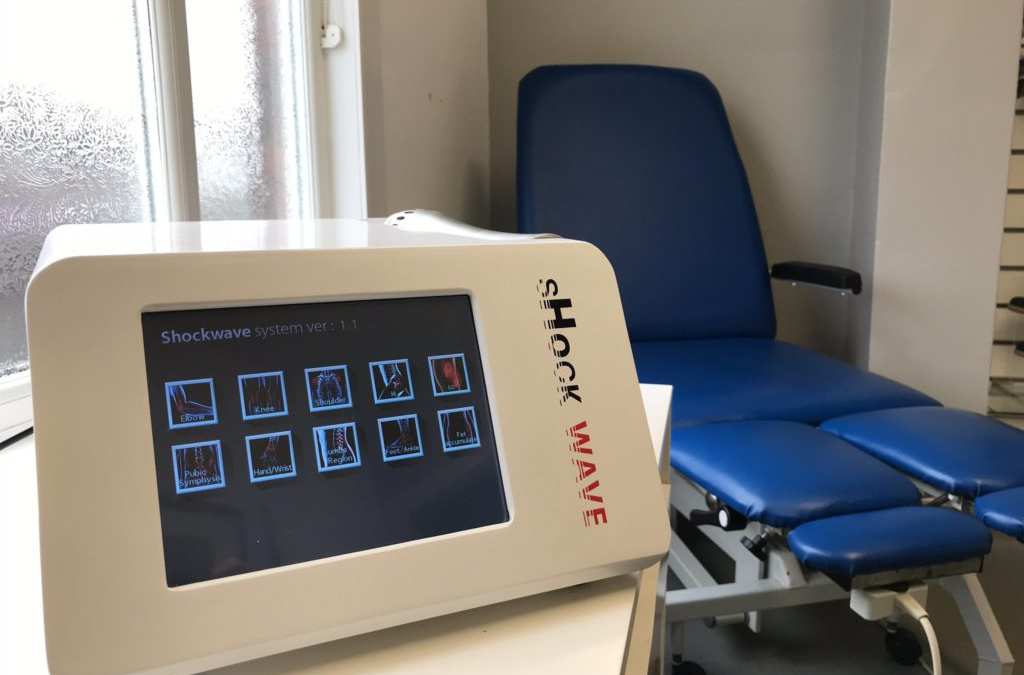What is Shockwave Therapy?
Shockwave therapy, or, Extracorporeal Shockwave Therapy (ESWT), is a highly effective treatment for pain, chronic soft tissue injuries, as well as certain types of bone conditions.
An extracorporeal shockwave is a non-invasive, non-electrical high energy sound wave that passes through the body via a hand-held probe. The shockwaves produce a rapid increase in blood flow to the localised target area. This works to break-down the fibrous scar tissue which builds up over time and is particularly prevalent with chronic conditions.
This break-down of scar tissue is the key to why shock wave therapy is so effective. Unlike normal tissue, scar tissue is non-elastic and will inhibit and prevent normal movement and function, and will ultimately weaken the healthy tissue surrounding it, often leading to further damage and pain.
By increasing circulation and breaking down scar tissue, shockwave therapy will stimulate cell regeneration and promote normal healing and rapid reduction of pain. The normal function can then be restored.
How successful is Shockwave Therapy?
After only 3 or 4 treatments with shockwave therapy, over 80% of patients report a reduction of pain and a regaining of normal function.
Research is steadily growing for this cutting-edge technology, and the latest reports are confirming shockwave therapy is an effective treatment for numerous soft tissue injuries, pain and certain bone related conditions like heel spurs.
If you would like to make an appointment or speak to one of our experienced practitioners, please call 01444453874
What does Shockwave Therapy treat?
Plantar Fasciitis
Probably the most common condition that is known to respond very well to Shockwave Therapy is Plantar Fasciitis, often known as Policeman’s foot.
The pain is usually felt on the medial tubercle (the calcaneus) of the heel and is felt along the Soft Tissues of the foot to the base of the toes. This is the inside of the calcaneal, the bone that has the heel strike with the ground. Given the foot’s biomechanical structure, a heal strike as you walk is the most common footfall pattern, but this alone is not necessarily the cause of any problems. Factors through the hip and joints above the ankle can also contribute to this condition.
Plantar Fasciitis is the condition where we often see patients with high BMI, diabetes and other pathologies that affect the foot. The foot might be the last thing in their consideration, but a nasty plantar fasciitis can cause significant discomfort and pain for patients. Given the impact on their mobility. It can also lead to the deterioration of overall health and wellbeing.
With this condition the symptoms are often morning pain or pain after resting. Typically, there is some improvement with movement as the area ‘warms up’ however with more severe conditions the patient simply can’t walk with the ease and mobility which they would want.
Because so many people are treated for this condition each year, many patients we see have already had injections, physiotherapy, acupuncture and heel supports. Lifting the heal and arches by way of customised orthotic devises can be of great help to correct the biomechanical issue, however, patients are sometimes still left with an unremitting pain.
The largest double-blind study into the effectiveness of Shockwave Therapy was conducted by Gerdesmeyer in 2008. It conclusively proved that Shockwave Therapy is a safe and effective treatment for recalcitrant (recalcitrant means not responding or simply being stubborn to heal) plantar fasciitis and we subsequently have had NICE guidelines from 2009. The complex biomechanical nature of the foot can make it a difficult area to treat but the results are among the most successful of any Shockwave treatment.
Other Conditions where Shockwave Therapy is Effective
Shockwave therapy is an effective on a significant range of soft tissue and skeletal ailments. Here are some examples of conditions where shockwave therapy has effectively treated and restored normal function:
- Patellar tendonitis (jumper‘s knee)
- Tibial stress syndrome (shin pain)
- Achilles tendonitis
- Hip pain
- Heel pain, heel spurs
- Chronic neck dysfunction
What can I expect during my consultation?
At your first visit, you will meet one of our experienced Specialist Podiatrists, who will discuss your symptoms and condition, followed by a comprehensive and non-invasive ultrasound scan before treatment of the area of pain or injury.
Shockwave therapy will be fully explained, and treatment will commence. Shockwave treatment typically lasts for 10-15 minutes.
There are no known side effects of Shockwave Therapy and most patients experience a significant reduction in their pain. Occasionally, a mild diffuse pain can be experienced within a few hours of treatment and may last 24 hours.
Underlying factors when Shockwave Therapy would not be appropriate
There are a few circumstances when shockwave therapy should not be used, so please inform your practitioner if you are experiencing any of the conditions or circumstances listed below:
● If pregnant or trying to conceive
● For application over open growth plates – not suitable for under 18 years.
● Over metal pins or plates
● Malignant Tumours
● Nerve or circulation disorders
● Infections
● If the patient is taking anticoagulants
Costs for treatment
During your appointment, our practitioners will combine treatment, advice, and a comprehensive ultrasound scan, along with your shockwave therapy to ensure you get the best chance of a successful result.
Research and experience suggest that a minimum of three treatments is required, but this can be discussed with our practitioners during your appointment.
Please contact the admin team on 01444453874 to make a booking.

